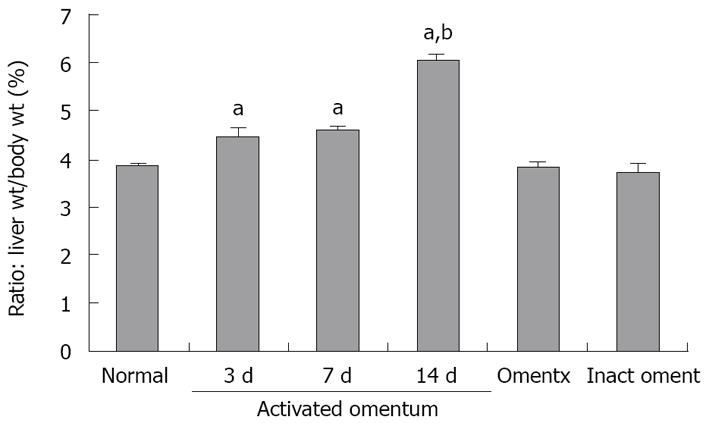Copyright
©2009 The WJG Press and Baishideng.
World J Gastroenterol. Mar 7, 2009; 15(9): 1057-1064
Published online Mar 7, 2009. doi: 10.3748/wjg.15.1057
Published online Mar 7, 2009. doi: 10.3748/wjg.15.1057
Figure 2 Liver mass (as a ratio of body weight) at different times after injury and fusing of the activated omentum to the wound.
The ratio of liver wt/body wt in normal rats was established to be 3.85% ± 0.07%. ‘Omentx’ are rats in which the omentum was removed before liver injury (n = 12) and ‘inact oment’ are rats in which the liver was injured, but the omentum was inactivated (n = 12). Liver regeneration following wounding and fusion of activated omentum was rapid, and by day 3 the liver grew to 110% of the original mass. The liver continued to grow, reaching a maximum size of 150% of the original mass by day 14, after which growth stopped (day 28, data not shown). Normal = 15 rats and there were 6 in each of the 3, 7, 14 and 28 d groups. aDenotes statistical difference from normal or ‘omentx’ or ‘inact oment’ groups at P < 0.05. bDenotes statistical difference from day 3 and day 7 groups at P < 0.05. With regard to ‘omentx’ and ‘inact oment’ groups, no differences were seen at days 3, 7, 14 and 28 compared to Normal (only day 14 data is shown in the figure; n = 3).
- Citation: Singh AK, Pancholi N, Patel J, Litbarg NO, Gudehithlu KP, Sethupathi P, Kraus M, Dunea G, Arruda JA. Omentum facilitates liver regeneration. World J Gastroenterol 2009; 15(9): 1057-1064
- URL: https://www.wjgnet.com/1007-9327/full/v15/i9/1057.htm
- DOI: https://dx.doi.org/10.3748/wjg.15.1057









